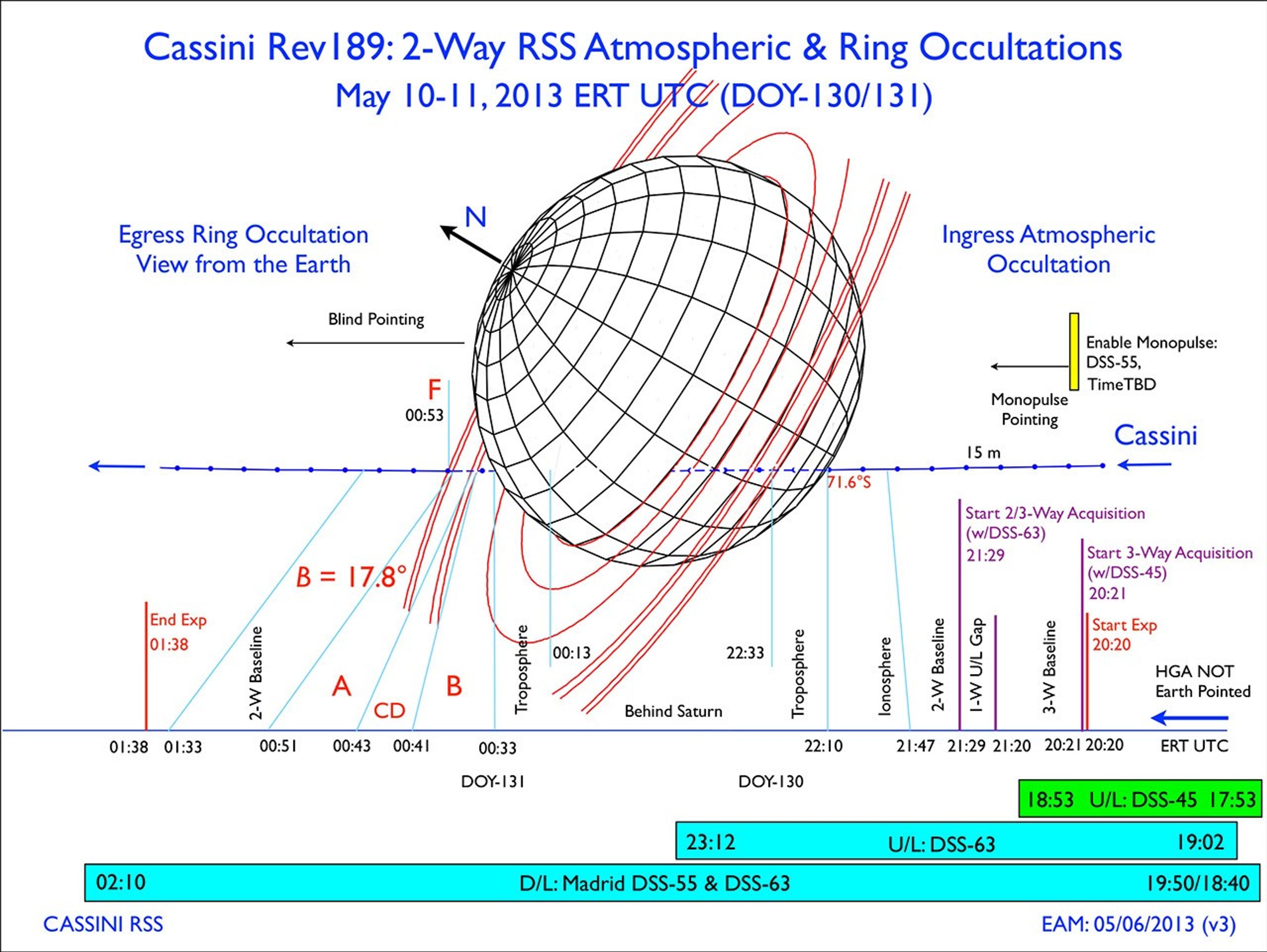Cassini is orbiting Saturn with a 9.6-day period in a plane inclined 61.7 degrees from the planet's equatorial plane. The most recent spacecraft tracking and telemetry data were obtained on May 15 by the 70-meter diameter Deep Space Network station at Madrid, Spain. Except for some science instrument issues described in previous reports, the spacecraft continues to be in an excellent state of health with all of its subsystems operating normally.
Cassini is orbiting Saturn with a 9.6-day period in a plane inclined 61.7 degrees from the planet's equatorial plane. The most recent spacecraft tracking and telemetry data were obtained on May 15 by the 70-meter diameter Deep Space Network station at Madrid, Spain. Except for some science instrument issues described in previous reports, the spacecraft continues to be in an excellent state of health with all of its subsystems operating normally. Information on the present position of the Cassini spacecraft may be found on the "Present Position" page at: http://saturn.jpl.nasa.gov/mission/presentposition/.
Cassini continued operating under control of the ten-week command sequence S78 while teams worked on S79, S80, and S81, which will be uplinked and go active on the spacecraft in June, August, and October respectively. Planning continued for the 2016 start of Cassini's F-ring and Proximal Orbits phase.
Wednesday, May 8 (DOY 128)
The Ultraviolet Imaging Spectrograph (UVIS), the Composite Infrared Spectrometer (CIRS), and the Visible and Infrared Mapping Spectrometer (VIMS) wrapped up an observation studying Saturn’s aurora, as part of the coordinated Saturn Auroral Campaign.
Next, CIRS had the spacecraft turn to observe the unlit side of the rings to gather data on their composition, and VIMS squeezed in a couple of two-minute Saturn storm-watch observations.
Thursday, May 9 (DOY 129)
The Imaging Science Subsystem (ISS) created a movie of the B ring's outer edge, which is where it meets the Cassini Division, to study edge modes and to better understand the interactions between the rings and Saturn’s satellites. A movie from 2009 clearly shows why this area is of interest:
Friday, May 10 (DOY 130)
CIRS observed Saturn near its south pole to measure helium abundance at the point where the Radio Science Subsystem (RSS) team would shortly be conducting an occultation experiment. Then, following a VIMS calibration activity, a Deep Space Network (DSN) station in Australia began sending its continuous reference signal, timed to arrive at Saturn right when RSS had the spacecraft's high-gain antenna pointing to Earth to receive it. Cassini generated its downlink frequencies at S, X, and Ka-band based on the received uplink frequency and beamed them through Saturn's ionosphere and troposphere while going behind the planet at a high southern latitude. Emerging again from behind Saturn, the signals probed the atmosphere and rings. This occultation experiment was useful for profiling the density waves and bending waves that populate the A ring, and also for providing additional constraints on the kinematics of circular and non-circular Cassini Division features and the outer edge of the B ring. The measurements will also be used to determine particle size distribution of resolved features in the rings. This graphic illustrates the view from Earth as Cassini was being occulted:/resources/15816
Saturday, May 11 (DOY 131)
The Cosmic Dust Analyzer observed E-ring particles while the spacecraft crossed through Saturn's ring plane, to characterize seasonal variation of the ring's structure. Cassini then passed periapsis going 45,235 kilometers per hour relative to Saturn, at about 316,000 kilometers above the cloud tops. Next, VIMS viewed the sunlit side of the rings at high phase-angle illumination and at high resolution to better determine ring composition. ISS then performed a full azimuthal survey of the "giant propeller" region between the Encke Gap and the A ring's outer edge. The propellers (http://go.usa.gov/YyGR) in this region are large and can be individually tracked, but their orbits are known to evolve.
Sunday, May 12 (DOY 132)
After doing calibrations using two stars, VIMS observed an egress occultation of the infrared-bright star W Hydrae as it made a radial pass behind the entire ring system due to the spacecraft's orbital motion. CIRS then did a radial scan of the rings to further their phase/latitude mapping and to assist efforts to model the directional emissivity of the rings. This is necessary for evaluating the integrated flux leaving the rings; the directional dependence is important in determining whether particle spin or packing structure affects the emission. UVIS then observed Saturn to create spectral images of its visible hemisphere.
Monday, May 13 (DOY 133)
UVIS created a spectral map of Saturn’s rings. The instrument's view of spatial variation in the ultraviolet albedo, and of water absorption, help characterize surface properties of the ring particles.
The Realtime Operations team uplinked the second part of the ten-week S78 command sequence, using a 34-meter diameter DSN station in Spain. After two hours twenty-eight minutes all 4,861 individual commands were verified as having been correctly received.
Cassini's final targeted encounter with Saturn’s second largest moon Rhea occurred on March 9, 2013. An image of its ancient and heavily cratered surface obtained then was featured today: /resources/15811
Tuesday, May 14 (DOY 134)
ISS observed the faint rings nearly edge-on. ISS, CIRS and VIMS then performed an observation in the Titan monitoring campaign from 2.3 million kilometers away, after which ISS made an observation in the Satellite Orbit Campaign. Finally, ISS watched while Saturn's satellite Mimas transited in front of the smaller Pandora.































